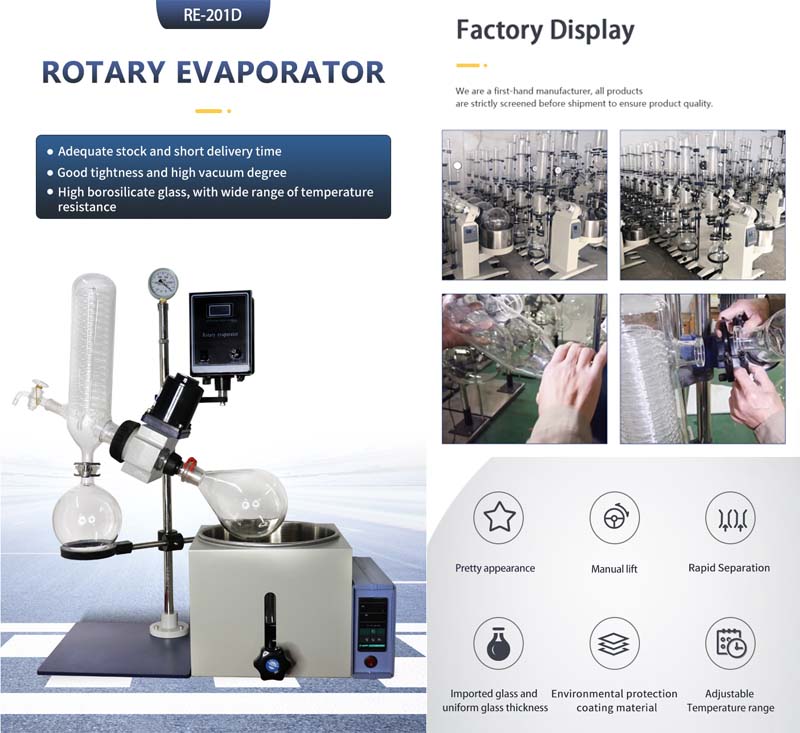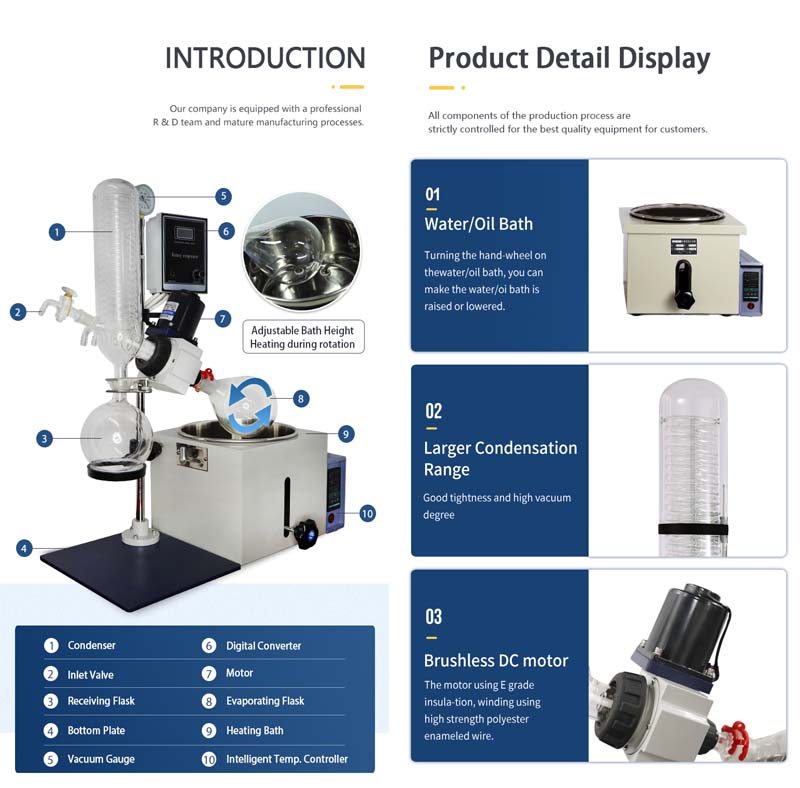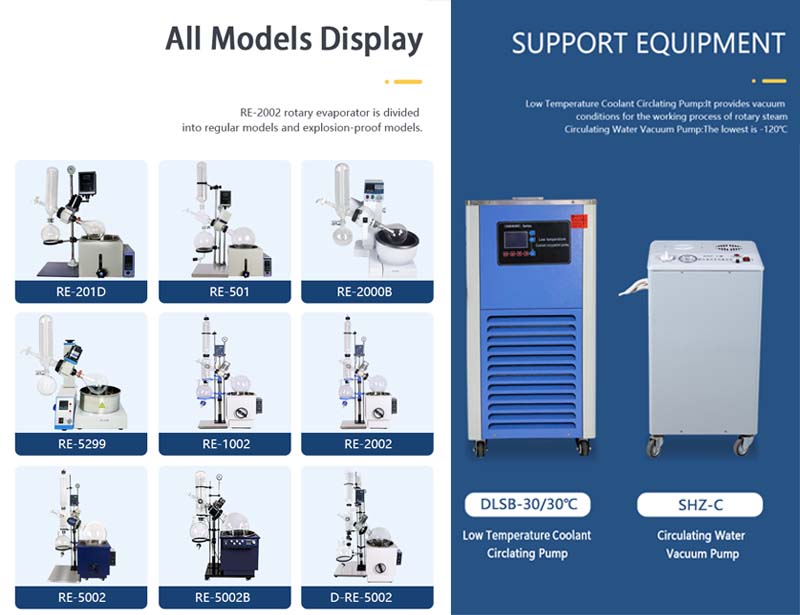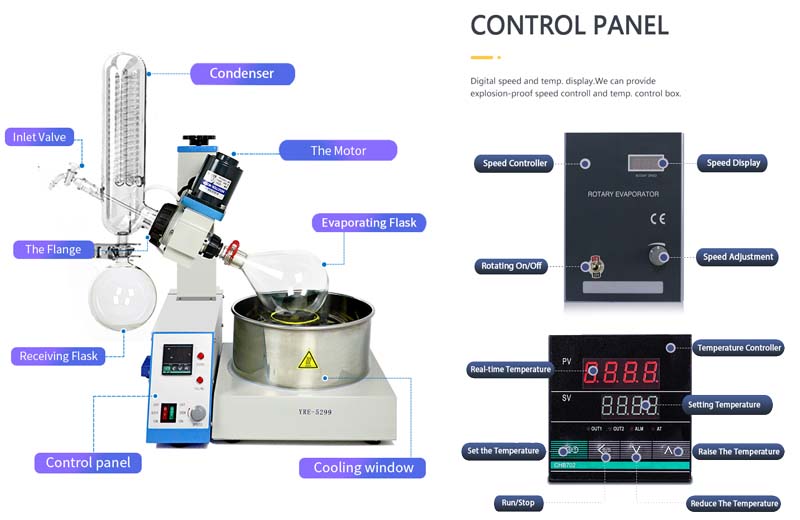The rotary evaporator is a device that uses a rotary evaporation flask to increase the evaporation area and place it in a water bath under reduced pressure while rotating and heating, so that the solution in the flask is diffused and evaporated. It is a basic instrument for concentration, drying and recycling in chemical industry, institutions of higher learning and scientific research laboratories for manufacturing and analysis experiments. Reliable and reproducible distillation results typically found on other, more expensive distillation equipment can be achieved.
How to use the rotary evaporator:
1. Connect the hose to the condensate faucet, and use the vacuum hose to connect the vacuum pump to evacuate.
2. Pour water into the heating tank (preferably pure water. If you use tap water, please leave it for a day or two before using it).
3. The method of adjusting the angle of the main unit: as long as the main unit and the column connecting screw are loosened, the main unit can be tilted arbitrarily between 0-45 degrees.
4. Turn on the condensed water, turn on the power supply, connect the evaporating bottle to the host (don't let go), turn on the vacuum pump to make it reach a certain degree of vacuum, and then let go.
5. Connect the power supply of the water bath to heat the bath, turn on the temperature control switch, set the temperature according to the requirements of use, and the heating tank starts to automatically temperature-controlled heating.
6. Turn on the speed control switch, slowly adjust the rotation speed of the knob, the evaporating bottle starts to rotate, and the rotary steamer enters the trial operation. Once the temperature and vacuum are within the required range, the solvent can be evaporated to the receiving bottle. (If the evaporating temperature requirement is too high, a low-temperature coolant circulation pump is required)
7. After the evaporation is completed, stop the rotation first, then open the atmosphere, then stop the water pump, and finally turn off the vacuum pump after the evaporation is completed, open the vent valve above the condenser to make it communicate with the atmosphere, release the liquid in the collection bottle, close the speed control switch and adjust the Turn on the temperature switch, remove the evaporating flask, and the evaporation process is over.

The working principle of the rotary evaporator:
Rotary evaporators are mainly used for continuous distillation of a large number of volatile solvents under reduced pressure, such as distillation extracts and receiver liquids during chromatographic separation. The basic principle of the rotary evaporator is the vacuum distillation of the distillation flask under continuous rotation. As a heat source for distillation, it is often equipped with a corresponding constant temperature water tank.
Through electronic control, the flask is rotated at a constant speed at a suitable speed to increase the evaporation area. The evaporating flask is under negative pressure by means of a vacuum pump. The evaporating flask is placed in a water bath for constant temperature heating while rotating, and the solution in the flask is heated, diffused and evaporated in the rotating flask under negative pressure. The rotary evaporator system can be sealed and decompressed to 400~600 mm Hg; the solvent in the distillation flask is heated with a heating bath, and the heating temperature can be close to the boiling point of the solvent; at the same time, it can be rotated at a speed of 50~160 rpm, The solvent is formed into a thin film and the evaporation area is increased. In addition, under the action of the high-efficiency cooler, the hot vapor can be quickly liquefied and the evaporation rate can be accelerated.

Rotary evaporator product advantages:
1. Small size - save space
The rotary evaporator innovatively adopts the longitudinal design of the rotating shaft, which reduces the width of the product to 25cm, which is one third of the width of the traditional rotary evaporator. The standard 1.8m fume hood can place up to 5 rotary evaporators, which fully saves the space resources of the fume hood. .
2. Array combination - improve efficiency
The special interface design of the rotary evaporator can realize the parallel use of multiple units, sharing a vacuum system and condensation recovery system. It is very suitable for the needs of simultaneous processing of multiple samples and improves work efficiency.
Each rotary evaporator can independently set working parameters such as temperature, rotation speed, time, etc., and can independently raise and lower the sample bottle.
The rotary evaporator has an independent quick release vacuum button, which can release the vacuum independently without affecting the normal operation of other rotary evaporators.
3. Time work - less nursing
The rotary evaporator has the ability to work regularly, and the working conditions and working hours can be set according to experience. When the time is reached, the rotary evaporator will automatically stop rotating, release the vacuum, lift the sample bottle, and leave the heating water bath, and automatically stop the sample evaporation and concentration.
4. Double protection - avoid pollution
The rotary evaporator is equipped with a liquid backflow prevention interface, which can effectively prevent the liquid backflow in the pipeline during the sample processing process, avoid contamination of the sample, and ensure the accuracy of the analysis results.

Precautions when using the rotary evaporator:
1. When using it, first draw a small vacuum (about 0.03MPa), and then turn on the rotation to prevent the distillation flask from slipping; when it stops, stop the rotation first, hold the distillation flask by hand, and let it open to the atmosphere, and wait until the vacuum degree drops to about 0.04MPa. Stop the vacuum pump to prevent the distillation bottle from falling off and sucking back.
2. Each grinding port, sealing ring and joint need to be coated with a layer of vacuum grease before installation. If the vacuum degree is too low, pay attention to check the air tightness of each joint, vacuum tube and glass bottle.
3. When rotary-evaporating air-sensitive substances, connect a nitrogen balloon to the exhaust port, first pass a burst of nitrogen gas, exhaust the air in the rotary evaporator, and then connect the sample bottle for rotary evaporation. After evaporating, release nitrogen to increase the pressure, then turn off the pump, and then remove the sample bottle and seal it.
4. If the viscosity of the sample is very large, the rotation speed should be slowed down and rotated slowly by hand, so that a new liquid level can be formed and the solvent can be evaporated.
5. Glass parts should be handled with care, and should be washed, dried or dried before installation.
6. Water must be added before the heating tank is energized, and dry burning without water is not allowed.
7. If the vacuum cannot be pumped up, it needs to be checked
(1) Whether the joints and interfaces are sealed
(2) Whether the sealing ring and the sealing surface are effective
(3) Whether the vacuum grease between the main shaft and the sealing ring is well coated
(4) Whether the vacuum pump and its hose are leaking
(5) Whether the glass parts are cracked, broken or damaged

Common problems and solutions of rotary evaporators:
The rotary evaporator is the equipment in our laboratory, so how to solve the problems during use? After reading the following paragraphs, everyone must be able to quickly understand which instant noodles are faulty and how to solve them!
1. Motor heating
Fault phenomenon
1. Motor temperature rise (case temperature - room temperature)
△T≤40℃ is normal.
2. If △T>40℃, follow the right countermeasure.
3. The display part of the flat panel flashes, indicating that the motor current is overloaded.
Solution
1. No need to deal with it, you can continue to use it.
2. Reduce the stirring blade to reduce the load.
②Appropriately increase the speed and use medium speed.
③Avoid the rotational resonance point.
④Discharge the abnormal resistance of the mechanical part.
⑤Maintain the sealing and lubricating parts.
2. Motor speed (only the highest speed)
Fault phenomenon
1. Check whether the tachogenerator coil is open circuit, the normal resistance is about 400Ω.
2. The generator coil is short-circuited with the casing.
3. The generator magnetic ring does not rotate.
4. The generator magnetic ring is broken.
Solution
1. The generator is disconnected, replace the coil or connect the disconnection point.
2. Loosen the generator cover at the rear end of the motor to eliminate the short circuit.
3. Tighten the nut.
4. Replace the generator magnetic ring.
3. The motor does not turn
Fault phenomenon
1. The indicator light (or digital display) of the electric control box does not light up.
2. The indicator light (or digital display) of the electric control box is on, check whether the connection between the plugs inside and outside the electric box is loose or broken.
3. Inverter protection function display.
Solution
1. Replace the fuse or confirm that there is no abnormality in the power supply.
2. Re-insert the plug and connect the disconnection.
3. Replace the circuit board or electric control box.
4. Connect the ground wire properly or change the working location.
4. The vacuum cannot be drawn
Fault phenomenon
1. There is a solvent in the container, which is limited by the saturated vapor pressure.
2. The capacity of the vacuum pump decreases.
3. The vacuum hose, the joint is loose, and the vacuum gauge leaks.
4. The instrument is used for the pressure-holding test. In the absence of any solvent, all external valves and pipelines are closed, and the pressure is maintained for one minute. The pointer of the vacuum gauge should not move, indicating that the air tightness is good.
5. There are debris in the discharge valve and pressure control valve.
6. The glass is broken.
Solution
1. Empty the solvent and test with an empty bottle.
2. Change the oil (water) of the vacuum pump, clean and repair it.
3. Check and eliminate section by section along the vacuum pipeline.
4. ①Reassemble, clean the glass grinding mouth, apply vacuum silicone grease, and align the flange mouth to tighten.
②Replace the failed sealing ring.
5. Cleaning.
6. Replace or repair.
5. Warm up the bathtub
Fault phenomenon
1. When the bath temperature is higher than the set temperature, the "OUT" or "ON" green indicator light in the temperature controller will not go out. (1-2℃ is normal)
2. The "OUT" or "ON" green indicator light in the temperature controller has been turned off, and the heating continues.
3. The digital display bath temperature is much lower than the actual bath temperature.
Solution
1. Change the temperature controller.
2. Replace the solid state relay or relay board.
3. Change the probe or temperature controller.
6. The bathtub is not heated
Fault phenomenon
1. The bath tub is innumerable.
2. The "OUT" or "ON" green indicator light in the temperature controller is on and does not heat.
3. When the bath temperature is lower than the set temperature, the "OUT" or "ON" green indicator light in the temperature controller does not light up.
Solution
1. Check the power supply.
2. Change the heating coil.
Replace the solid state relay or relay board.
3. Change the temperature controller.
4. Check the probe wiring or replace the probe.





